Introducing Two Fixed Platforms in the Yellow Sea and East China Sea Supporting Long-Term Satellite Ocean Color Validation: Preliminary Data and Results
Abstract
:1. Introduction
2. Location Selection, Platform Design, and Instrument Deployment
3. Data and Methods
3.1. In Situ Data
3.2. Satellite Data
3.3. Data Matchup
3.4. Data Comparison
3.5. Statistics
4. Result
4.1. Inter-Comparison AOD, Es, and Rrs at the Muping Site
4.2. The Spectral and Temporal Feature of AOD and Rrs
4.3. Validation Rrs and AOD of MODIS and OLCI
4.4. Evaluation the ACOLITE and SeaDAS
5. Discussion
5.1. Spatial Homogeneity of Water at Two Sites
5.2. Satellite-Derived Rrs in the Blue Bands
6. Conclusions
Author Contributions
Funding
Data Availability Statement
Acknowledgments
Conflicts of Interest
References
- Gregg, W.W.; Casey, N.W. Global and regional evaluation of the SeaWiFS chlorophyll data set. Remote Sens. Environ. 2004, 93, 463–479. [Google Scholar] [CrossRef]
- Hu, C.; Lee, Z.; Franz, B. Chlorophyll a algorithms for oligotrophic oceans: A novel approach based on three-band reflectance difference. J. Geophys. Res. 2012, 117, C01011. [Google Scholar] [CrossRef] [Green Version]
- Blondeau-Patissier, D.; Gower, J.F.R.; Dekker, A.G.; Phinn, S.R.; Brando, V.E. A review of ocean color remote sensing methods and statistical techniques for the detection, mapping and analysis of phytoplankton blooms in coastal and open oceans. Prog. Oceanogr. 2014, 123, 123–144. [Google Scholar] [CrossRef] [Green Version]
- Lahet, F.; Stramski, D. MODIS imagery of turbid plumes in San Diego coastal waters during rainstorm events. Remote Sens. Environ. 2010, 114, 332–344. [Google Scholar] [CrossRef]
- Wang, M.; Hu, C.; Barnes, B.B.; Mitchum, G.; Lapointe, B.; Montoya, J.P. The great Atlantic Sargassum belt. Science 2019, 365, 83–87. [Google Scholar] [CrossRef]
- Franz, B.A.; Bailey, S.W.; Werdell, P.J.; McClain, C.R. Sensor-independent approach to the vicarious calibration of satellite ocean color radiometry. Appl. Opt. 2007, 46, 5068–5082. [Google Scholar] [CrossRef]
- Eplee, R.E.; Robinson, W.D.; Bailey, S.W.; Clark, D.K.; Werdell, P.J.; Wang, M.; Barnes, R.A.; McClain, C.R. Calibration of SeaWiFS. II. Vicarious techniques. Appl. Opt. 2001, 40, 6701–6718. [Google Scholar] [CrossRef]
- Song, Q.; Chen, S.; Xue, C.; Lin, M.; Du, K.; Li, S.; Ma, C.; Tang, J.; Liu, J.; Zhang, T.; et al. Vicarious calibration of COCTS-HY1C at visible and near-infrared bands for ocean color application. Opt. Express 2019, 27, A1615–A1626. [Google Scholar] [CrossRef]
- Barnes, B.B.; Cannizzaro, J.P.; English, D.C.; Hu, C. Validation of VIIRS and MODIS reflectance data in coastal and oceanic waters: An assessment of methods. Remote Sens. Environ. 2019, 220, 110–123. [Google Scholar] [CrossRef] [Green Version]
- Hlaing, S.; Harmel, T.; Gilerson, A.; Foster, R.; Weidemann, A.; Arnone, R.; Wang, M.; Ahmed, S. Evaluation of the VIIRS ocean color monitoring performance in coastal regions. Remote Sens. Environ. 2013, 139, 398–414. [Google Scholar] [CrossRef]
- Wang, M.; Tang, J.; Shi, W. MODIS-derived ocean color products along the China east coastal region. Geophys. Res. Lett. 2007, 34, L06611. [Google Scholar] [CrossRef]
- Fargion, G.; McClain, C.; Fukushima, H.; Nicolas, J.; Barnes, R. Ocean Color Instrument Intercomparisons and Cross-Calibrations by the SIMBIOS Project. In Proceedings of the Remote Sensing, Florence, Italy, 20–23 September 1999; Volume 3870. [Google Scholar]
- Werdell, P.; Bailey, S. The SeaWiFS Bio-optical Archive and Storage System (SeaBASS): Current Architecture and Implementation; Technical Report; NASA Goddard Space Flight Center: Greenbelt, MD, USA, 2002.
- Zibordi, G.; Berthon, J.-F.; Mélin, F.; D’Alimonte, D.; Kaitala, S. Validation of satellite ocean color primary products at optically complex coastal sites: Northern Adriatic Sea, Northern Baltic Proper and Gulf of Finland. Remote Sens. Environ. 2009, 113, 2574–2591. [Google Scholar] [CrossRef]
- Antoine, D.; d’Ortenzio, F.; Hooker, S.B.; Bécu, G.; Gentili, B.; Tailliez, D.; Scott, A.J. Assessment of uncertainty in the ocean reflectance determined by three satellite ocean color sensors (MERIS, SeaWiFS and MODIS-A) at an offshore site in the Mediterranean Sea (BOUSSOLE project). J. Geophys. Res. Ocean. 2008, 113, C07013. [Google Scholar] [CrossRef]
- Zibordi, G.; Mélin, F.; Berthon, J.-F.; Holben, B.; Slutsker, I.; Giles, D.; D’Alimonte, D.; Vandemark, D.; Feng, H.; Schuster, G.; et al. AERONET-OC: A Network for the Validation of Ocean Color Primary Products. J. Atmos. Ocean. Technol. 2009, 26, 1634–1651. [Google Scholar] [CrossRef]
- Zibordi, G.; Holben, B.; Mélin, F.; D’Alimonte, D.; Berthon, J.F.; Slutsker, I.; Giles, D. AERONET-OC: An overview. Can. J. Remote Sens. 2010, 36, 488–497. [Google Scholar] [CrossRef]
- Zhang, G.; Yang, S.; Yu, Z. Temporal and spatial changes of suspended sediment concentration and resuspension in the Yangtze River Estuary and its adjacent waters. Acta Geogr. Sin. 2004, 59, 260–266. [Google Scholar]
- Lou, S.; Russell, L.M.; Yang, Y.; Xu, L.; Lamjiri, M.A.; DeFlorio, M.J.; Miller, A.J.; Ghan, S.J.; Liu, Y.; Singh, B. Impacts of the East Asian Monsoon on springtime dust concentrations over China. J. Geophys. Res. (Atmos.) 2016, 121, 8137–8152. [Google Scholar] [CrossRef]
- Shen, F.; Verhoef, W.; Zhou, Y.; Salama, M.S.; Liu, X. Satellite Estimates of Wide-Range Suspended Sediment Concentrations in Changjiang (Yangtze) Estuary Using MERIS Data. Estuaries Coasts 2010, 33, 1420–1429. [Google Scholar] [CrossRef]
- Zhang, M.; Tang, J.; Dong, Q.; Song, Q.; Ding, J. Retrieval of total suspended matter concentration in the Yellow and East China Seas from MODIS imagery. Remote Sens. Environ. 2010, 114, 392–403. [Google Scholar] [CrossRef]
- Shen, F.; Zhou, Y.; Li, J.; He, Q.; Verhoef, W. Remotely sensed variability of the suspended sediment concentration and its response to decreased river discharge in the Yangtze estuary and adjacent coast. Cont. Shelf Res. 2013, 69, 52–61. [Google Scholar] [CrossRef]
- Lee, Z.; Carder, K.L.; Mobley, C.D.; Steward, R.G.; Patch, J.S. Hyperspectral Remote Sensing for Shallow Waters. I. A Semianalytical Model. Appl. Opt. 1998, 37, 6329–6338. [Google Scholar] [CrossRef]
- Holben, B.N.; Eck, T.F.; Slutsker, I.; Tanré, D.; Buis, J.P.; Setzer, A.; Vermote, E.; Reagan, J.A.; Kaufman, Y.J.; Nakajima, T.; et al. AERONET—A Federated Instrument Network and Data Archive for Aerosol Characterization. Remote Sens. Environ. 1998, 66, 1–16. [Google Scholar] [CrossRef]
- Zibordi, G.; Melin, F.; Hooker, S.B.; Alimonte, D.D.; Holben, B. An autonomous above-water system for the validation of ocean color radiance data. IEEE Trans. Geosci. Remote Sens. 2004, 42, 401–415. [Google Scholar] [CrossRef]
- Zibordi, G.; Holben, B.; Hooker, S.; Mélin, F.; Berthon, J.-F.; Slutsker, I.; Giles, D.; Vandemark, D.; Feng, H.; Rutledge, K.; et al. A Network for Standardized OceanColor Validation Measurements. Eos Trans. Am. Geophys. Union 2006, 87, 293–297. [Google Scholar] [CrossRef] [Green Version]
- Hooker, S.B.; Zibordi, G. Platform perturbations in above-water radiometry. Appl. Opt. 2005, 44, 553–567. [Google Scholar] [CrossRef]
- Giles, D.M.; Sinyuk, A.; Sorokin, M.G.; Schafer, J.S.; Smirnov, A.; Slutsker, I.; Eck, T.F.; Holben, B.N.; Lewis, J.R.; Campbell, J.R.; et al. Advancements in the Aerosol Robotic Network (AERONET) Version 3 database-automated near-real-time quality control algorithm with improved cloud screening for Sun photometer aerosol optical depth (AOD) measurements. Atmos. Meas. Tech. 2019, 12, 169–209. [Google Scholar] [CrossRef] [Green Version]
- Bodhaine, B.A.; Wood, N.B.; Dutton, E.G.; Slusser, J.R. On Rayleigh Optical Depth Calculations. J. Atmos. Ocean. Technol. 1999, 16, 1854–1861. [Google Scholar] [CrossRef]
- Mobley, C.D. Estimation of the remote-sensing reflectance from above-surface measurements. Appl. Opt. 1999, 38, 7442–7455. [Google Scholar] [CrossRef]
- Thuillier, G.; Hersé, M.; Labs, D.; Foujols, T.; Peetermans, W.; Gillotay, D.; Simon, P.C.; Mandel, H. The Solar Spectral Irradiance from 200 to 2400 nm as Measured by the SOLSPEC Spectrometer from the Atlas and Eureca Missions. Sol. Phys. 2003, 214, 1–22. [Google Scholar] [CrossRef]
- Deschamps, P.-Y.; Fougnie, B.; Frouin, R.; Lecomte, P.; Verwaerde, C. SIMBAD: A field radiometer for satellite ocean-color validation. Appl. Opt. 2004, 43, 4055–4069. [Google Scholar] [CrossRef]
- Morel, A.; Gentili, B. Diffuse reflectance of oceanic waters. II Bidirectional aspects. Appl. Opt. 1993, 32, 6864–6879. [Google Scholar] [CrossRef]
- Lee, Z.P.; Du, K.; Voss, K.J.; Zibordi, G.; Lubac, B.; Arnone, R.; Weidemann, A. An inherent-optical-property-centered approach to correct the angular effects in water-leaving radiance. Appl. Opt. 2011, 50, 3155–3167. [Google Scholar] [CrossRef]
- Lee, Z.; Carder, K.L.; Arnone, R.A. Deriving Inherent Optical Properties from Water Color: A Multiband Quasi-Analytical Algorithm for Optically Deep Waters. Appl. Opt. 2002, 41, 5755–5772. [Google Scholar] [CrossRef]
- Vanhellemont, Q.; Ruddick, K. Turbid wakes associated with offshore wind turbines observed with Landsat 8. Remote Sens. Environ. 2014, 145, 105–115. [Google Scholar] [CrossRef] [Green Version]
- Vanhellemont, Q.; Ruddick, K. Atmospheric correction of metre-scale optical satellite data for inland and coastal water applications. Remote Sens. Environ. 2018, 216, 586–597. [Google Scholar] [CrossRef]
- Vanhellemont, Q. Adaptation of the dark spectrum fitting atmospheric correction for aquatic applications of the Landsat and Sentinel-2 archives. Remote Sens. Environ. 2019, 225, 175–192. [Google Scholar] [CrossRef]
- Gordon, H.R.; Wang, M. Retrieval of water-leaving radiance and aerosol optical thickness over the oceans with SeaWiFS: A preliminary algorithm. Appl. Opt. 1994, 33, 443–452. [Google Scholar] [CrossRef]
- Bailey, S.W.; Franz, B.A.; Werdell, P.J. Estimation of near-infrared water-leaving reflectance for satellite ocean color data processing. Opt. Express 2010, 18, 7521–7527. [Google Scholar] [CrossRef]
- Mélin, F.; Sclep, G. Band shifting for ocean color multi-spectral reflectance data. Opt. Express 2015, 23, 2262–2279. [Google Scholar] [CrossRef]
- Tilstone, G.; Dall’Olmo, G.; Hieronymi, M.; Ruddick, K.; Beck, M.; Ligi, M.; Costa, M.; D’Alimonte, D.; Vellucci, V.; Vansteenwegen, D.; et al. Field Intercomparison of Radiometer Measurements for Ocean Colour Validation. Remote Sens. 2020, 12, 1587. [Google Scholar] [CrossRef]
- Zibordi, G.; Ruddick, A.; Ansko, I.; Moore, G.; Kratzer, S.; Icely, S.; Noorma, A. In situ determination of the remote sensing reflectance: An inter-comparison. Ocean Sci. 2012, 8, 567–586. [Google Scholar] [CrossRef] [Green Version]
- Qin, P.; Simis, S.G.H.; Tilstone, G.H. Radiometric validation of atmospheric correction for MERIS in the Baltic Sea based on continuous observations from ships and AERONET-OC. Remote Sens. Environ. 2017, 200, 263–280. [Google Scholar] [CrossRef] [Green Version]
- Feng, H.; Vandemark, D.; Campbell, J.W.; Holben, B.N. Evaluation of MODIS ocean colour products at a northeast United States coast site near the Martha’s Vineyard Coastal Observatory. Int. J. Remote Sens. 2008, 29, 4479–4497. [Google Scholar] [CrossRef]
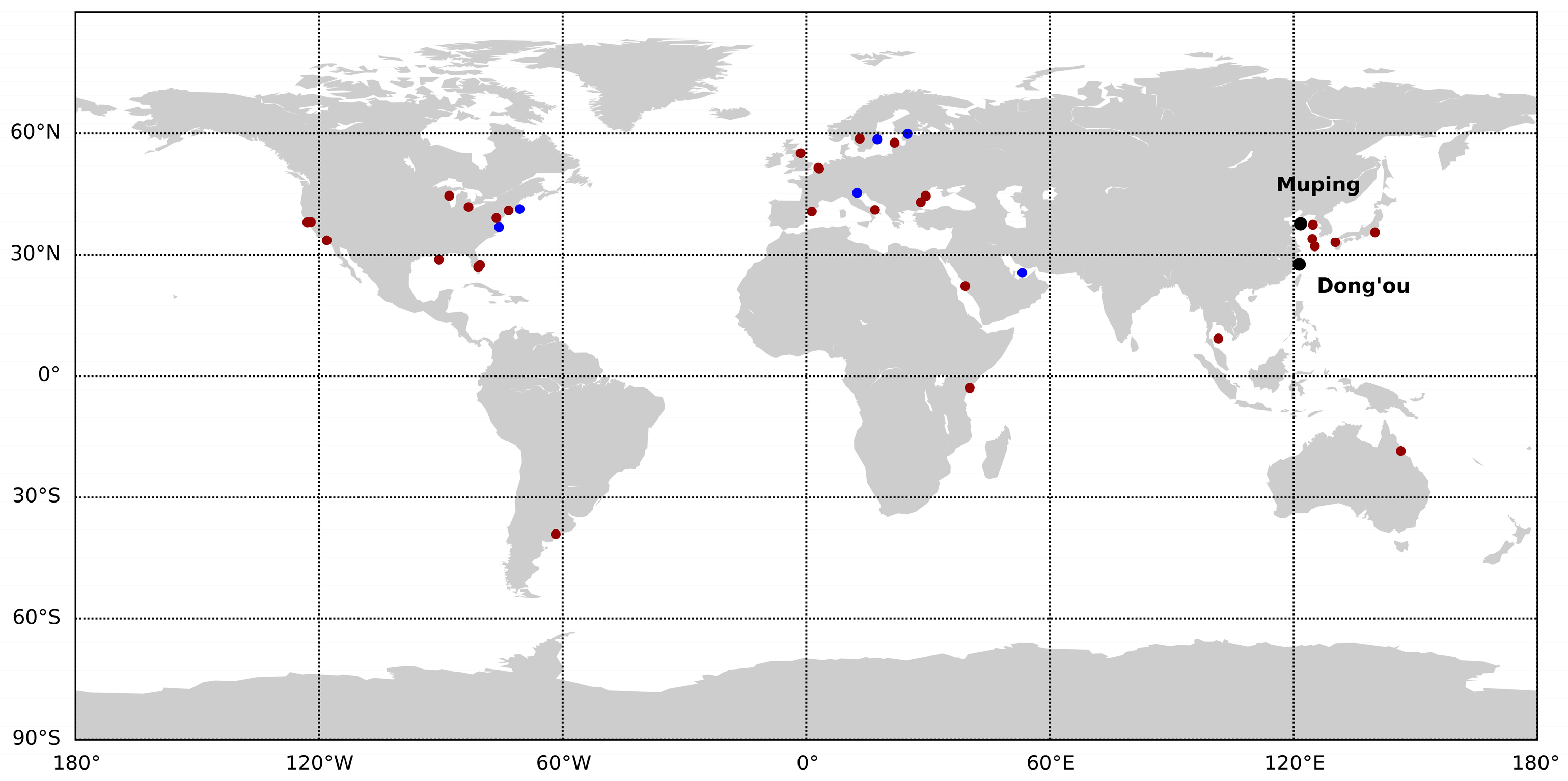
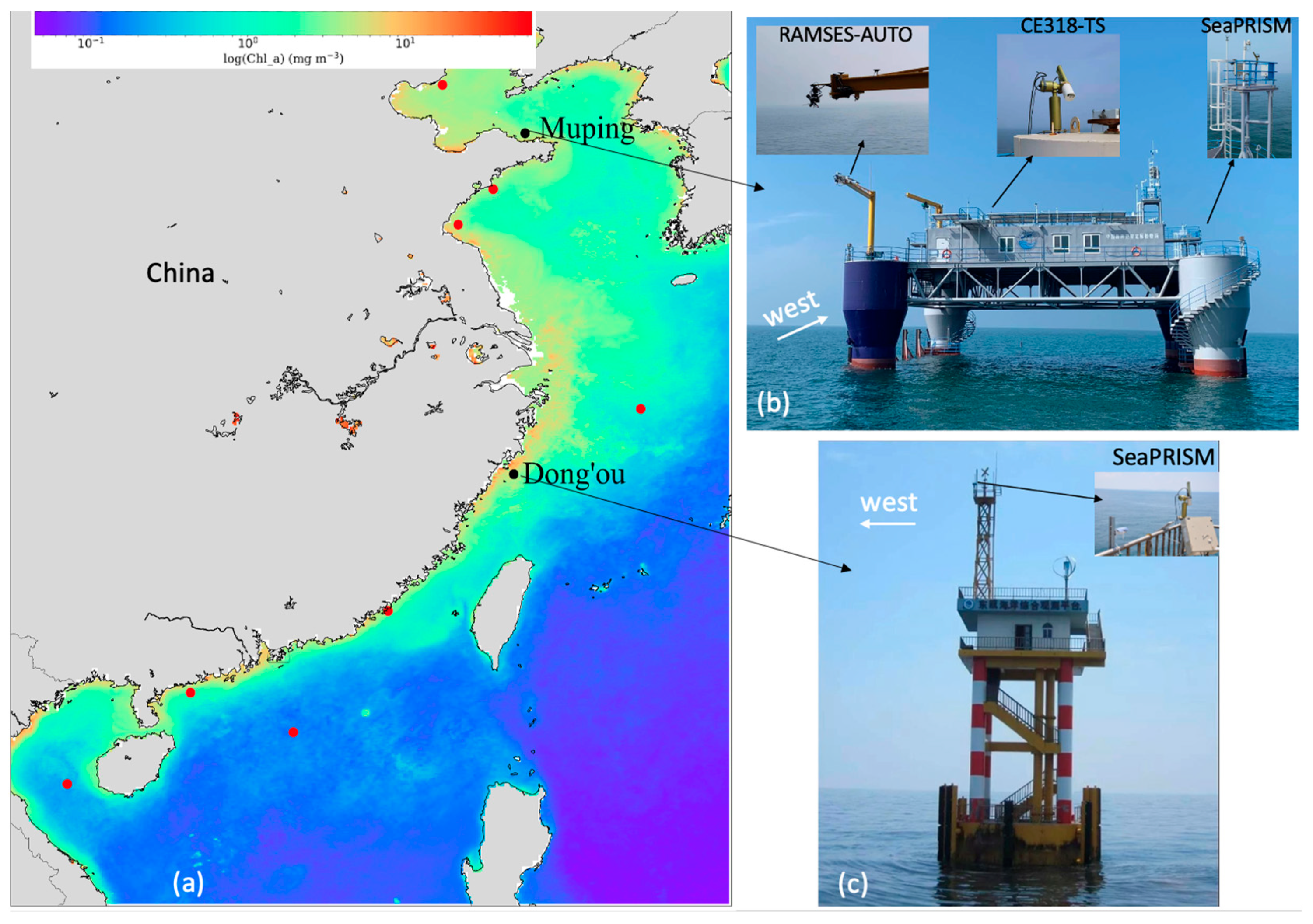
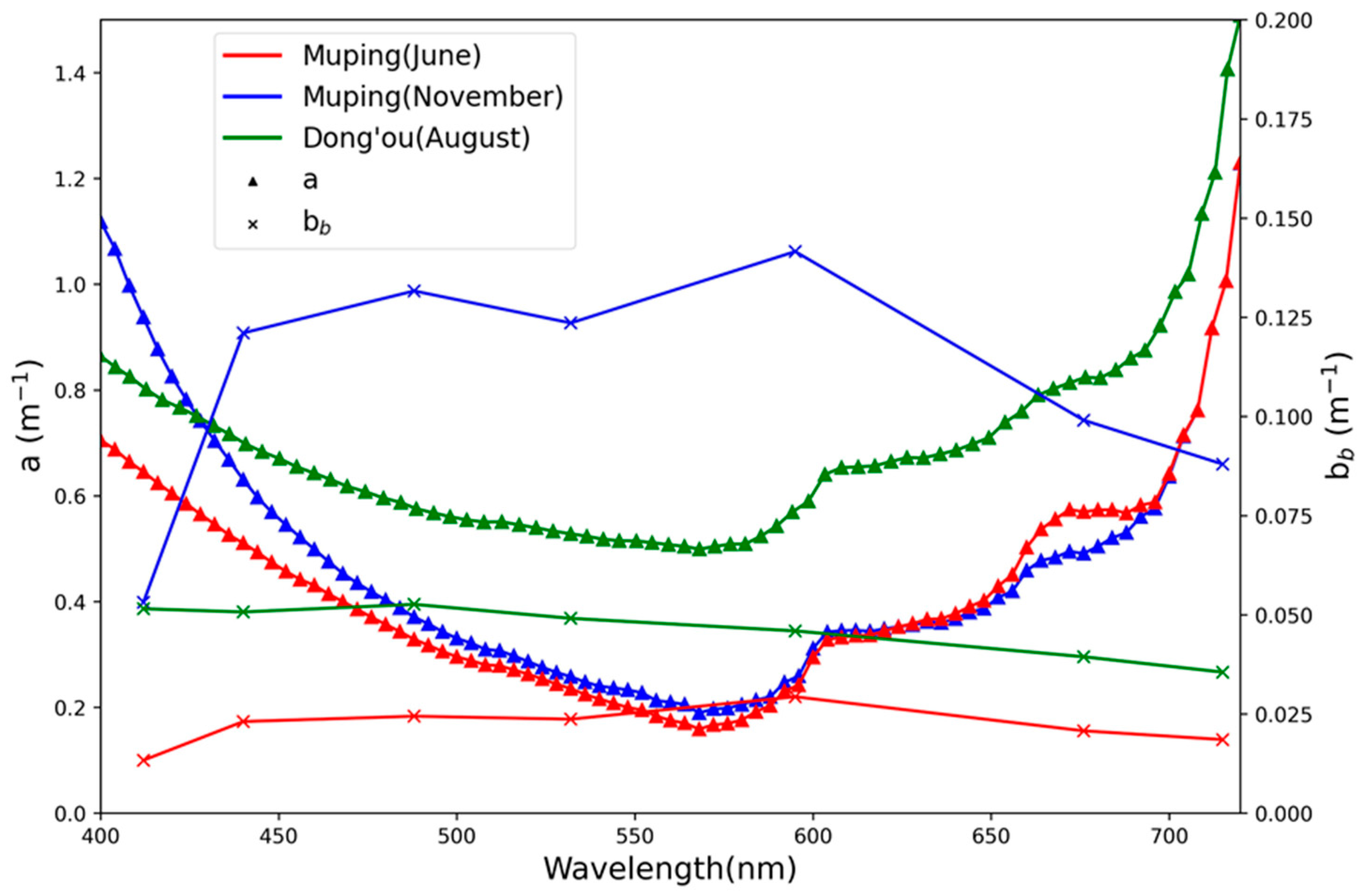

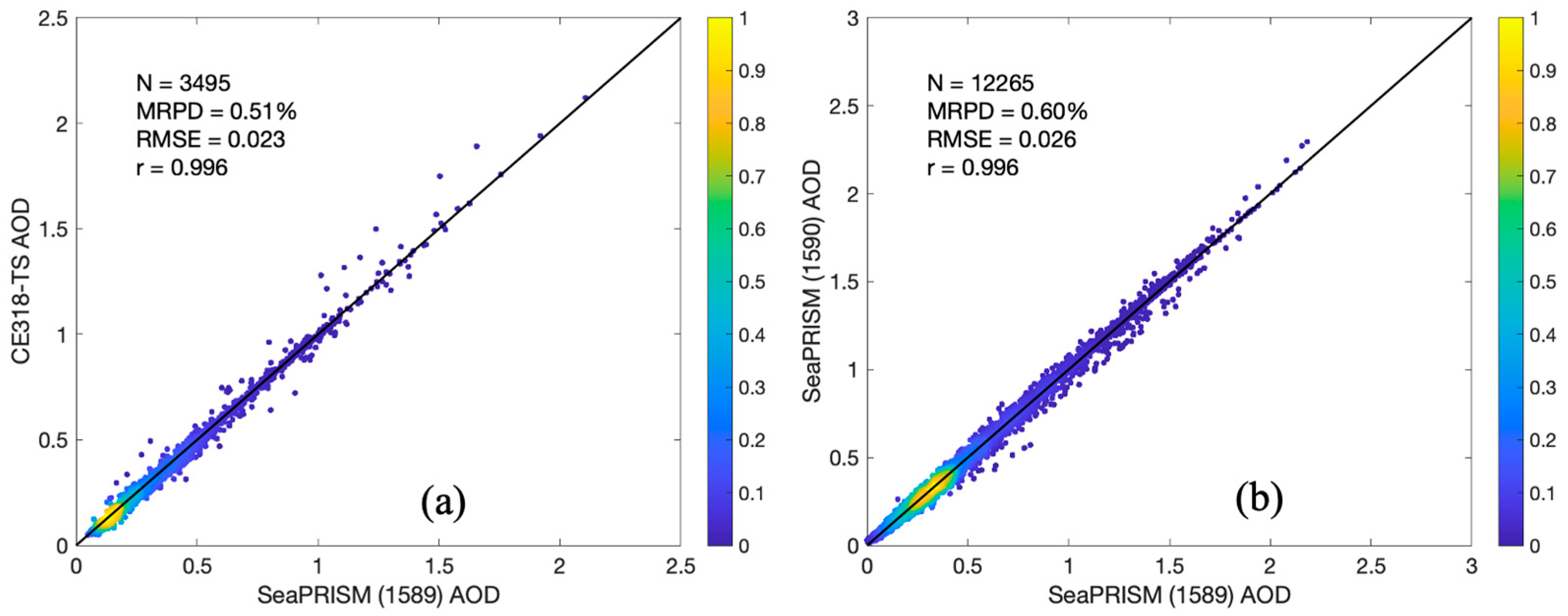
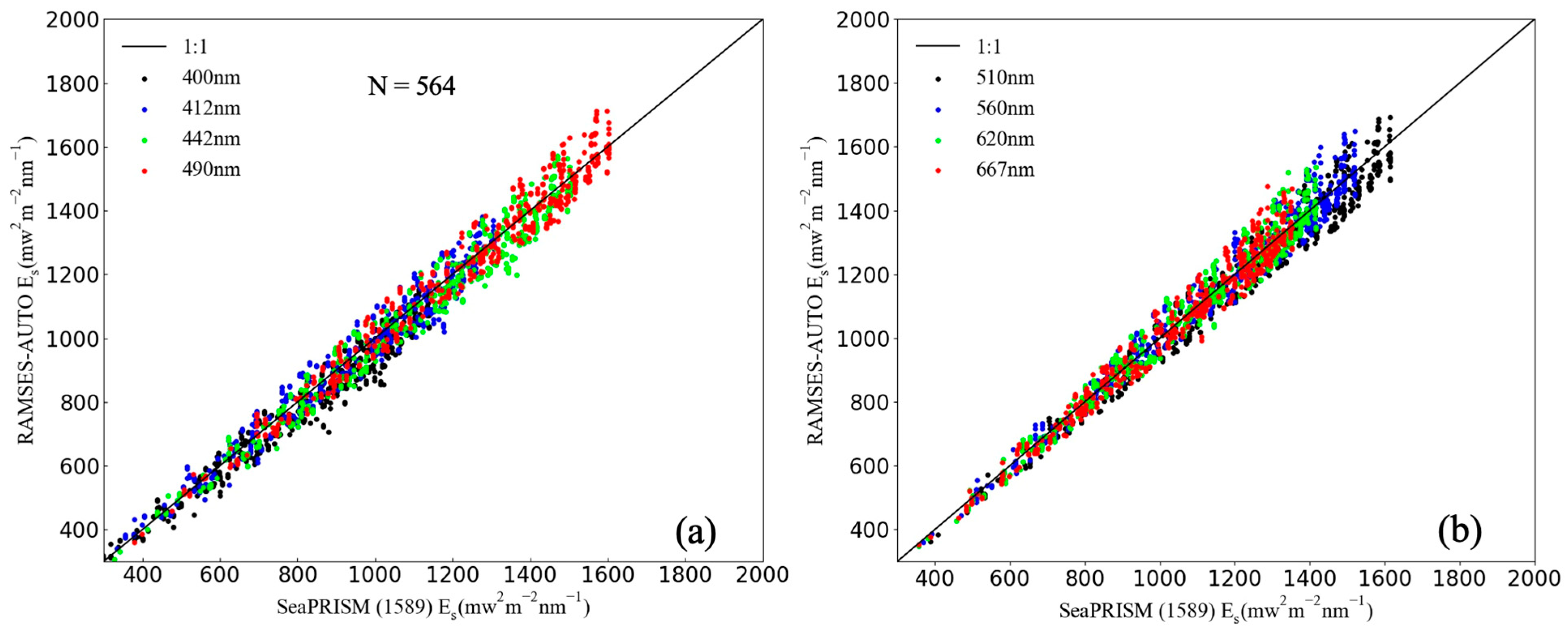

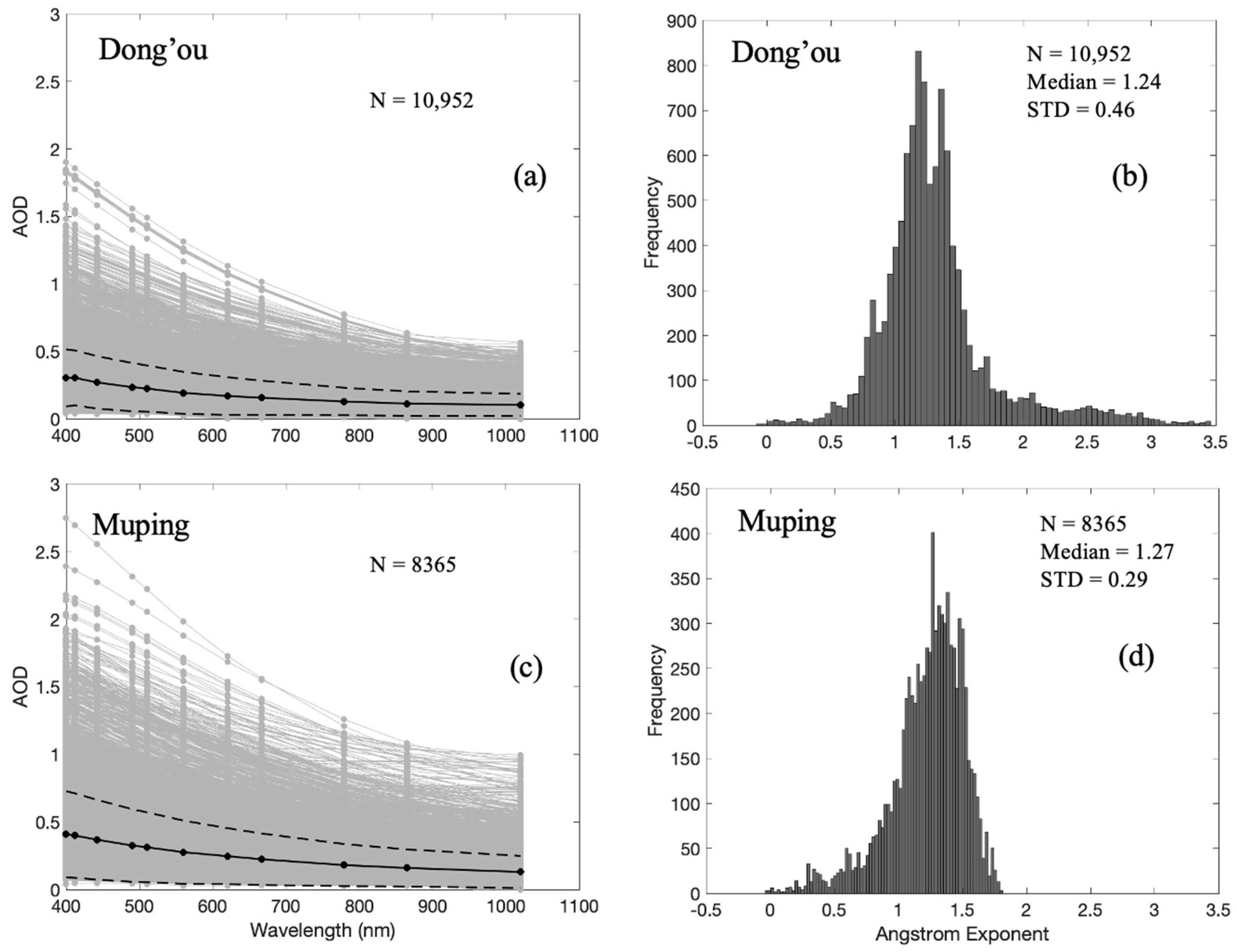
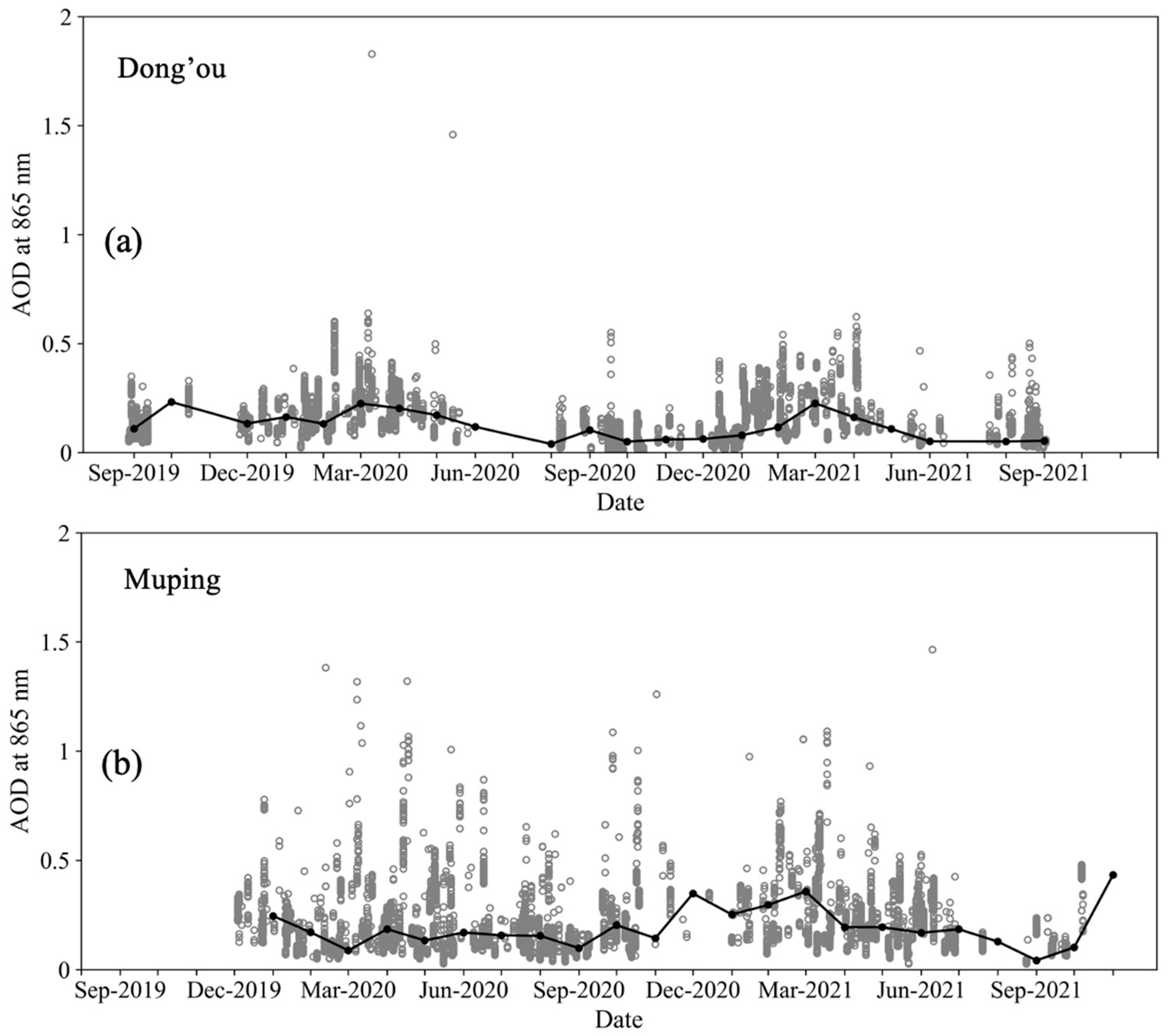

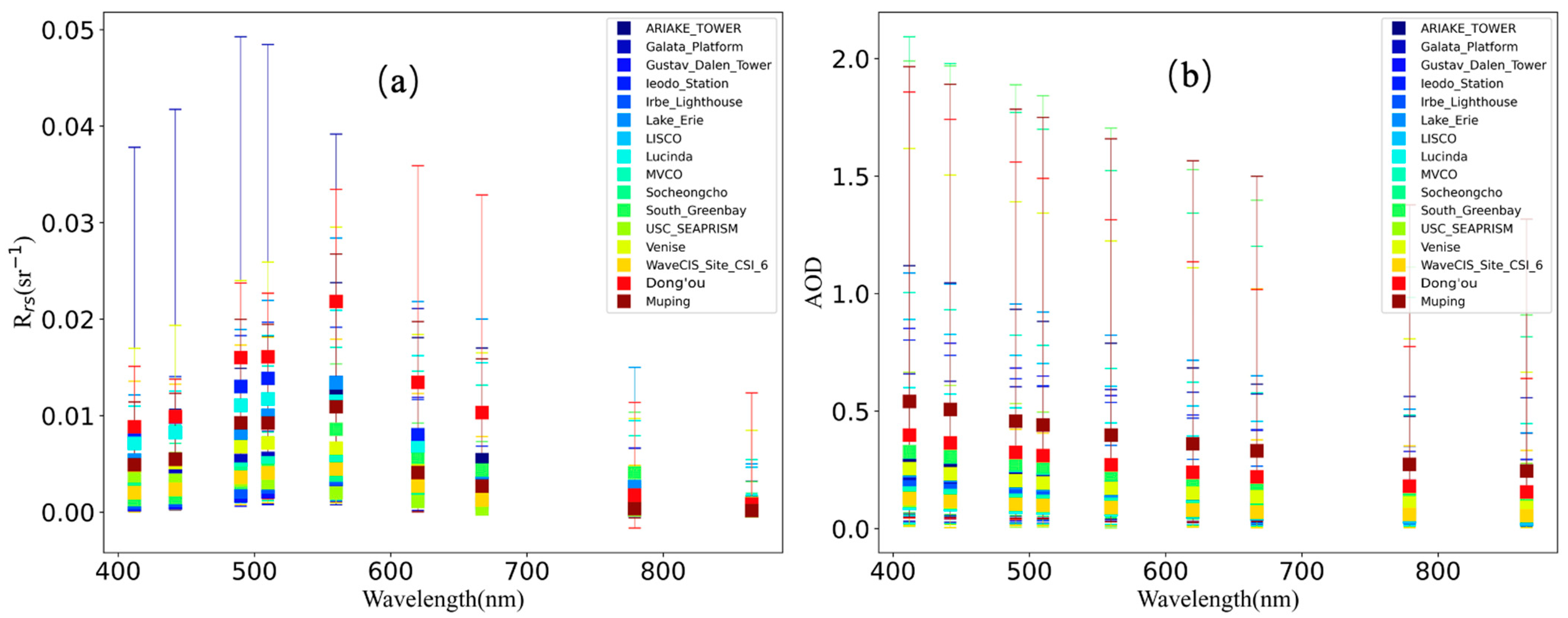
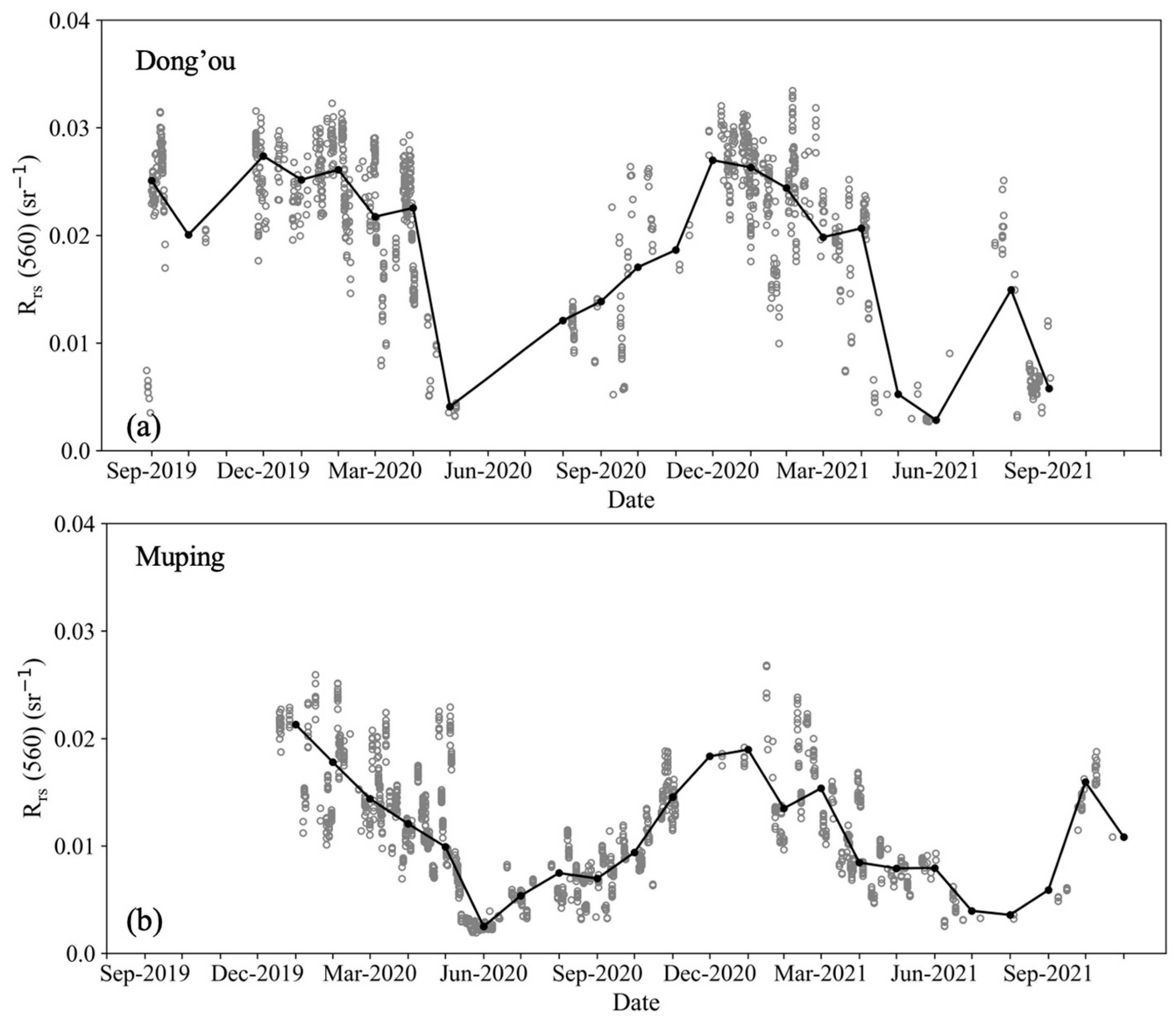

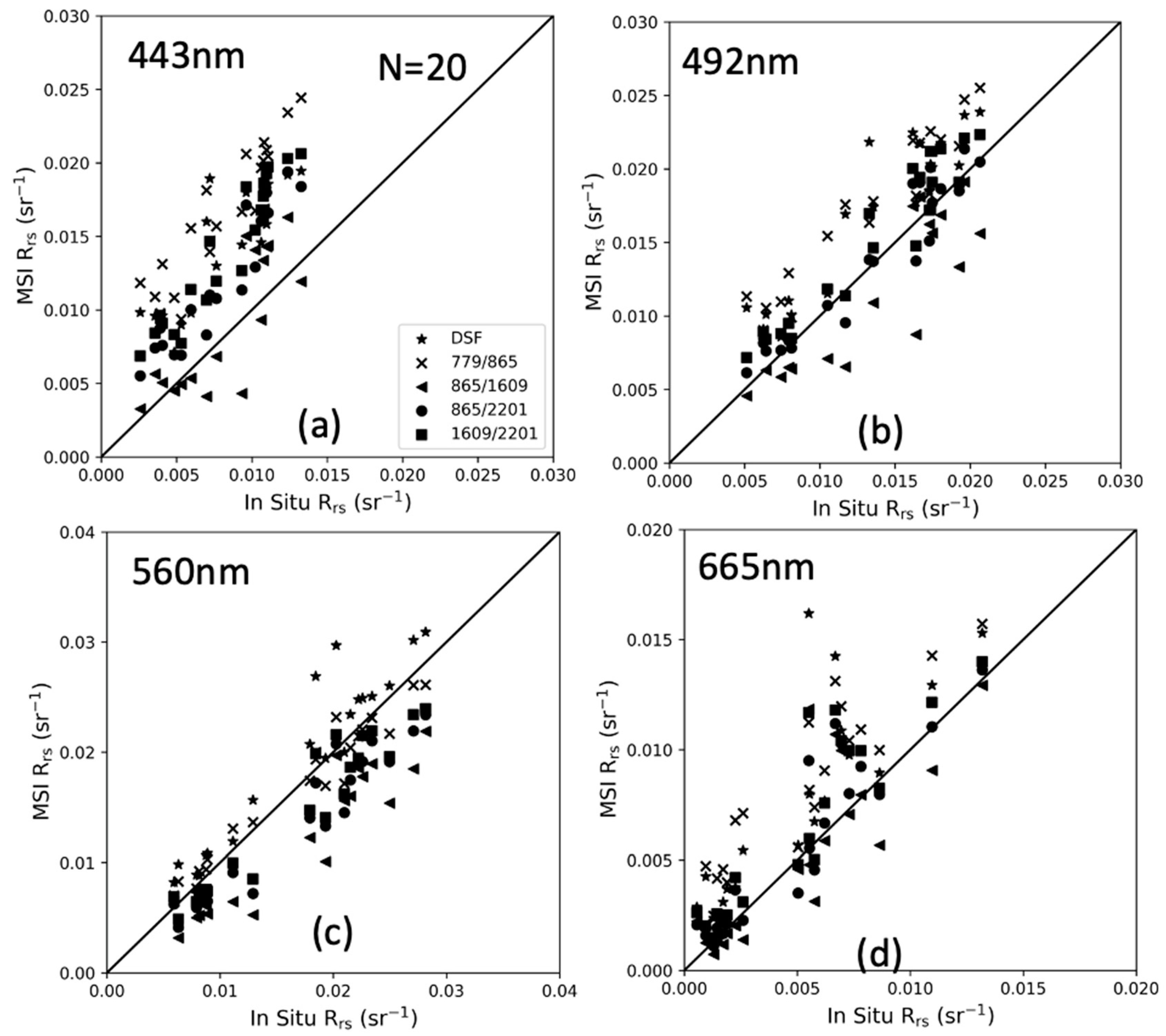



| Name | Location | Type | Depth | Bottom Contribution | Distance | Height |
|---|---|---|---|---|---|---|
| Muping | 121.701°E 37.681°N | Semi-submersible | 18 m | <10−3 | 22 km | 10 (7) m |
| Dong’ou | 121.355°E 27.675°N | Bottom-supported | 30 m | <10−17 | 25 km | 13 (10) m |
| SeaPRISM | MODISA | OLCI-3A&3B | MSI |
|---|---|---|---|
| 400 | 400 | ||
| 412 | 412 | 412 | |
| 442 | 443 | 442 | 443 |
| 469 | |||
| 490 | 488 | 492 | |
| 510 | 510 | ||
| 531 | |||
| 547 | |||
| 560 | 555 | 560 | 560 |
| 620 | 620 | ||
| 645 | |||
| 667 | 667 | 665 | 665 |
| Wavelength (nm) | MRPD (%) | RMSE | mR | mB | r |
|---|---|---|---|---|---|
| 400 | 4.73 | 52.6 | 0.97 | −31.9 | 0.98 |
| 412 | 3.70 | 46.2 | 1.00 | 0.3 | 0.98 |
| 442 | 3.74 | 51.6 | 0.99 | −17.3 | 0.99 |
| 490 | 3.14 | 50.6 | 1.00 | 1.1 | 0.99 |
| 510 | 3.96 | 56.4 | 0.98 | −27.2 | 0.99 |
| 560 | 2.90 | 49.3 | 1.00 | 6.6 | 0.99 |
| 620 | 2.88 | 45.9 | 1.00 | 2.9 | 0.99 |
| 667 | 2.84 | 44.1 | 1.00 | 2.1 | 0.98 |
| Wavelength (nm) | MRPD (%) | RMSE | mR | mB | r |
|---|---|---|---|---|---|
| 400 | 9.67 | 0.0008 | 1.06 | 0.0002 | 0.86 |
| 412 | 9.48 | 0.0009 | 1.07 | 0.0003 | 0.90 |
| 442 | 9.29 | 0.0008 | 1.00 | 0.0001 | 0.95 |
| 490 | 6.33 | 0.0013 | 1.06 | 0.0005 | 0.94 |
| 510 | 5.30 | 0.0012 | 1.06 | 0.0006 | 0.96 |
| 560 | 6.92 | 0.0013 | 0.99 | −0.0001 | 0.96 |
| 620 | 6.60 | 0.0007 | 1.02 | 0 | 0.96 |
| 667 | 7.92 | 0.0005 | 1.01 | 0 | 0.96 |
| MODISA | OLCI-3A | OLCI-3B | |||||
|---|---|---|---|---|---|---|---|
(nm) | MRPD (%) | RMSE (sr−1) | (nm) | MRPD (%) | RMSE (sr−1) | MRPD (%) | RMSE (sr−1) |
| 412 | 22.92 | 0.0034 | 400 | 26.63 | 0.0029 | 39.47 | 0.003 |
| 443 * | 21.95 | 0.0033 | 412 | 23.28 | 0.0027 | 34.15 | 0.0028 |
| 469 * | 10.45 | 0.0029 | 442 | 14.86 | 0.0022 | 23.10 | 0.0025 |
| 488 * | 10.99 | 0.0028 | 510 | 10.49 | 0.0018 | 10.74 | 0.0019 |
| 531 * | 8.15 | 0.0026 | 560 | 6.62 | 0.0017 | 8.26 | 0.0017 |
| 547 * | 9.71 | 0.0027 | 620 | 9.03 | 0.0016 | 13.24 | 0.0013 |
| 555 * | 10.16 | 0.0024 | 665 | 12.86 | 0.0016 | 13.46 | 0.0009 |
| 645 * | 14.19 | 0.0018 | |||||
| 667 | 10.45 | 0.0013 | |||||
| DSF | EXP(779/865) | EXP(865/1609) | EXP(865/2201) | EXP(1609/2201) | ||
|---|---|---|---|---|---|---|
| ACOLITE | Rrs (443) | 70.0% | 30.7% | 50.1% | 68.5% | 107.6% |
| Rrs (492) | 26.6% | 21.0% | 14.3% | 12.6% | 32.9% | |
| Rrs (560) | 16.1% | 31.7% | 21.4% | 14.2% | 8.2% | |
| Rrs (665) | 82.2% | 25.7% | 19.6% | 30.1% | 108.3% | |
| (550) | 46.6% | - | - | - | ||
| SeaDAS | Rrs (443) | - | 42.7% | 13.1% | 15.6% | 48.4% |
| Rrs (492) | - | 8.5% | 16.5% | 17.7% | 39.6% | |
| Rrs (560) | - | 6.0% | 11.5% | 12.6% | 24.9% | |
| Rrs (665) | - | 28.9% | 14.6% | 15.5% | 47.2% | |
| (865) | - | 30.4% | 14.3% | 15.1% | 23.2% |
Publisher’s Note: MDPI stays neutral with regard to jurisdictional claims in published maps and institutional affiliations. |
© 2022 by the authors. Licensee MDPI, Basel, Switzerland. This article is an open access article distributed under the terms and conditions of the Creative Commons Attribution (CC BY) license (https://creativecommons.org/licenses/by/4.0/).
Share and Cite
Song, Q.; Chen, S.; Hu, L.; Wang, X.; Shi, X.; Li, X.; Deng, L.; Ma, C. Introducing Two Fixed Platforms in the Yellow Sea and East China Sea Supporting Long-Term Satellite Ocean Color Validation: Preliminary Data and Results. Remote Sens. 2022, 14, 2894. https://doi.org/10.3390/rs14122894
Song Q, Chen S, Hu L, Wang X, Shi X, Li X, Deng L, Ma C. Introducing Two Fixed Platforms in the Yellow Sea and East China Sea Supporting Long-Term Satellite Ocean Color Validation: Preliminary Data and Results. Remote Sensing. 2022; 14(12):2894. https://doi.org/10.3390/rs14122894
Chicago/Turabian StyleSong, Qingjun, Shuguo Chen, Lianbo Hu, Xi Wang, Xinhao Shi, Xueyin Li, Linke Deng, and Chaofei Ma. 2022. "Introducing Two Fixed Platforms in the Yellow Sea and East China Sea Supporting Long-Term Satellite Ocean Color Validation: Preliminary Data and Results" Remote Sensing 14, no. 12: 2894. https://doi.org/10.3390/rs14122894
APA StyleSong, Q., Chen, S., Hu, L., Wang, X., Shi, X., Li, X., Deng, L., & Ma, C. (2022). Introducing Two Fixed Platforms in the Yellow Sea and East China Sea Supporting Long-Term Satellite Ocean Color Validation: Preliminary Data and Results. Remote Sensing, 14(12), 2894. https://doi.org/10.3390/rs14122894







